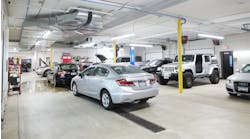In our world, the auto repair industry, we have two constant moving targets: car count and staffing. Maintaining these targets usually costs a lot of time and money. There is a process that won’t cost you a nickel; however, it will take great leadership to implement it into your daily routine. Let’s listen to Bryan Stasch, the Director of Client Fulfillment at ATI, as he explains the entire step-by-step process. Bryan oversees our coaching and training staff, which works with 1,167 shop owners every week implementing this process.
Like this article? Sign up for our enews blasts here.
Staffing, recruiting and hiring are all about having the right processes. You need a process for recruiting and attracting people, a testing process to see that they have the right skills for the role you are looking to fill, a process to see that you select the right person for the role and for your team and an orientation and training process to see that they get off to a good start. And that will be addressed in an upcoming article.
But like staffing, building and maintaining car count requires the right processes. Unfortunately, not only is marketing a constant moving target, it is only going to get harder and harder to get the cars you need each week to create the sales you need to be profitable.
Most people, when they look at marketing, think about two types: acquisition and retention. Both are necessary evils. But add two more categories – cheap but not easy, and easy but not cheap. Acquisition usually falls under the easy but not cheap category. Most shops usually pay someone to send some type of direct mail piece to either a zip code or a carrier route to hit a large number of potential customers, with a very low response rate. And at ATI, what we are seeing today is about 0.5 percent to 1 percent return.
Now I am not saying that this is bad, or a bad vendor, it just is what it is, unfortunately. Two things determine the response rate: top of mind awareness and in-market. Top of mind awareness refers to the question of whether your customers are thinking about car repair. In-market refers to whether they currently need the services you’re promoting. This direct mail method is somewhat expensive, but easy. The vendor does it for you.
Another Option
Then you have retention marketing, which is less expensive, due to smaller numbers to send and bigger response rates because these people already know you. At ATI, we are seeing response rates as high as 20 percent or better on retention marketing. But also think about this: if you educate your customers on maintenance schedules and maintenance services, you create the top of mind awareness. And if you follow my lead in this article, you create the in-market.
The best thing about most retention marketing is that it goes in the cheap but not easy category. That means it typically has little cost but does require manpower and time to make it happen. Along with the right attitude and the “want-to” at your front counter. Attitude and want-to are key to making retention marketing work.
At ATI, we have several of these processes that are cheap but require some work (not easy). Processes like these:
Referral programs
Key chains (not what you are thinking)
And – exit scheduling
Exit Scheduling Is Cheap but Not Easy
Exit scheduling is the process that I want to narrow in on. When you finalize your repair order and you are ready to kiss your customer good-bye for now, set the next service appointment before they leave. Creating the in-market as I mentioned earlier. This process saved the dental industry. And if you think about it, we are a lot like the dentist: because of fluoride in drinking water, cavities are less today than ever before, and cars are built better today as well. And your customers have no idea of how much pain they will be in without proper maintenance until we tell them. See what I mean?
So What Is the Process?
First, utilizing the management system or basic math, tell your customers that based on mileage and time, their vehicle will be ready for its next service on (day and time).
Second, educate the customer about the next service due and why it is necessary. Do not forget the benefits of the service and the benefits of setting an appointment now. This works great for maintenance schedules and your shop’s maintenance dance.
Third, write the date on an appointment card and give it to the customer. Also, if using Outlook or something similar, send an electronic reminder to the customer’s phone. You gotta love technology today.
Fourth, let them know that it is okay if they don’t know what their schedule looks like because you will be calling or emailing a week or two in advance just to confirm.
Fifth, follow up on the reminder call or email.
And sixth, have some type of reward for the customer when they return. This is also a key to success, but not as big as the attitude and the want-to. Rewards like a mystery envelope that contains a scratch-off for discounts on service or even your local state lottery, and that can only be opened by the service advisor when the customer shows up for that appointment.
It is this simple.
This exit scheduling is a freebie, and I can’t say it enough: the process requires the right attitude and definitely the right want-to. Some service advisors may not be comfortable with it, and may say their customers won’t like it, but how do you know if you haven’t tried? Then you have the ones that aren’t willing to put their heart into it. Then I question, why are they there?
Tips to Consider
Maybe use the word “reservation,” not “appointment.” What types of things do you set appointments for? You are probably thinking about pain. What types of things do you have reservations for? You are probably thinking about pleasure.
Focus on the customer’s schedule, not yours; make it sound like a benefit. For example, “Mrs. Smith, I see that you like to get in early, and to see that we can do that for you, how about we set your next service at 8 a.m.?”
Have the technicians get the mileage and next service for the writers.
Deliver constant customer education on the value of scheduled maintenance.
Maybe start with a suggested day or week for a follow-up. Then you can set up the exact day and time on the follow-up call.
Use rewards such as mystery envelopes or similar if they keep the appointment.
And it’s OK that it may take a few visits to get the customer trained.
Just get started. Sadly enough, most shops need more cars. But most have the right number of customers; they just don’t have the right number of visits per year, per customer, per car.
Now for the math:
What if you use this exit scheduling process with 50 customers this week? And what if only 25 set the appointment? And only 12 show up? That’s 12 cars more than the number that may have come in all by themselves. Twelve cars at, for example, a $350 ARO is $4,200 in sales.
What could this do for your customer visit frequency? What if 25 percent of your customer database came in one more time a year? What would that do to your sales?
Now the real question is, do you have the right attitude and the right want-to to follow through?
If you would like to have our Exit Scheduling Procedure Checklist for Service Advisor and Managers, go to www.ationlinetraining.com/2012-10. This will give your associates the exact do’s and don’ts to make this freebie stabilize your car count, increase your profits, keep you from losing to the competition and help you stay the most professional shop in your area.
Have articles like this sent to you weekly by signing up for our enews blasts here.



